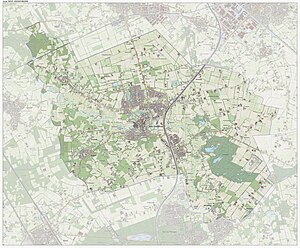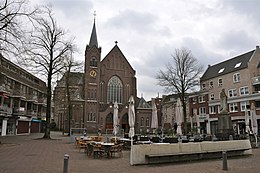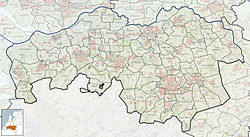Sint-Oedenrode | |
|---|---|
Town | |
|
From top down, left to right: St. Martin Church square, Henkenshage Castle, Dommelrode Castle and town hall, Knop Tower, former town hall, Monument to the Dutch, St. Paulus Hospice AD 1434, St. Damien Seminary | |
| Coordinates: 51°34′N 5°28′E / 51.567°N 5.467°E | |
| Country | Netherlands |
| Province | North Brabant |
| Municipality | Meierijstad |
| Merged | 2017 |
| Area | |
• Municipality | 64.94 km2 (25.07 sq mi) |
| Elevation | 11 m (36 ft) |
| Population (2021)[1] | |
• Municipality | 18,360 |
| • Density | 280/km2 (730/sq mi) |
| Time zone | UTC+1 (CET) |
| • Summer (DST) | UTC+2 (CEST) |
| Postcode | 5490–5492 |
| Area code | 0413 |
| Market rights | AD 1232 |
| Website | www |


Sint-Oedenrode (Dutch pronunciation: [sɪnt ˈudə(n)roːdə] ) is a town in the Dutch province of North Brabant.
Sint-Oedenrode is a moderately urbanized town in the Meierij of 's-Hertogenbosch. Sint-Oedenrode had a population of 18,360 as of 2021 and has an area of 64.94 km2 (25.07 sq mi). On 1 January 2017 Sint-Oedenrode, together with Schijndel and Veghel, merged into a new municipality called Meierijstad, creating the largest municipality of the North-Brabant province in terms of land area.[3]
The municipality traditionally had "vrijheidsrechten" (a predecessor of city rights), since 1232, until the abolishment of the privileges and introduction of the Municipalities Act in 1851. In those feudal times Sint-Oedenrode was referred to as a "Vlek" (market town). Today it is still a large town. From southeast to northwest, the town is split by the river Dommel.[4]
- ^ a b "Kerncijfers wijken en buurten 2021". Central Bureau of Statistics. Retrieved 17 April 2022.
- ^ "Postcodetool for 5492GD". Actueel Hoogtebestand Nederland (in Dutch). Het Waterschapshuis. Retrieved 4 November 2013.
- ^ CBS. "In twintig jaar bijna 240 gemeenten minder". www.cbs.nl (in Dutch). Retrieved 2016-12-30.
- ^ ROOIJ, W. VAN E.A., 750 Jaar Stadsrechten Sint-Oedenrode in 1982.











